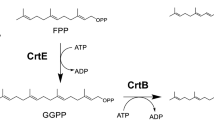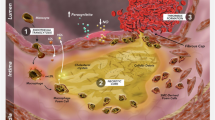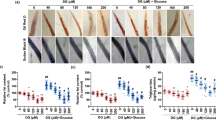Abstract
The effects of increasing concentrations of eicosapentaenoic acid (20∶5n−3; EPA) and oleic acid (18∶1n−9; OA) on esterification to triacylglycerols (TG) and phospholipids (PL), and the relationship to formation and secretion of the very low density lipoproteins (VLDL) were compared in the isolated perfused rat liver. Mixtures of EPA and OA were also studied to determine whether substrate levels of one fatty acid might influence the metabolism of the other. The basal perfusion medium, which contained 30% (vol/vol) washed bovine erythrocytes, 6% (wt/vol) bovine serum albumin (BSA), and 100 mg glucose/dL in Krebs-Henseleit bicarbonate buffer (pH 7.4) was recycled through the liver for 2 h. EPA or OA, as a complex with 6% BSA, was infused at rates of 70, 105, 140 and 210 μmol/h. In other experiments, mixtures of EPA and oleic acid (70 μmol total), with molar percentages of 100, 75, 50, 25 and 0% of each fatty acid were infused per hour. BSA (6%) in the buffer was infused alone and served as the control. At an infusion rate of 70 μmol EPA per hour, hepatic VLDL lipid output was not different from that when fatty acid was not infused (approximately half that when 70 μmol OA/h was infused). However, when larger amounts of EPA and OA were infused individually, rates of VLDL secretion were stimulated to a similar extent with either fatty acid. The apparent inhibitory influence of EPA on TG synthesis and VLDL lipid output when 70 μmol EPA were infused per hour could also be overcome by the presence of as little as 25 mol% OA in a mixture. Furthermore, the presence of EPA in the infused fatty acid mixture stimulated the incorporation of OA into TG, enhancing VLDL secretion. When EPA or OA was infused at rates exceeding 70 μmol/h, a constant amount of endogenously-derived fatty acids was incorporated into VLDL-TG, similar in amount to that when exogenous fatty acid was not supplied. However, when EPA was infused at a rate of 70 μmol/h, incorporation of endogenous fatty acid was depressed. AT this low rate of EPA infusion, esterification of EPA and endogenous fatty acid was inhibited. Conceivably, this may reflect the existence of independently-regulated pools of fatty acid (exogenous and endogenous), in that only exogenously available fatty acid preferentially enrich the secreted TG. Enrichment of PL by the infused fatty acid at the higher rates of fatty acid infusion showed similar, but much less pronounced, differences between VLDL and liver, compared to that for TG, providing additional evidence for a distinct metabolic pool of PL used for VLDL fabrication. It now appears that when EPA is available to the liver in high enough concentrations, or when OA (or other fatty acids?) is present in substrate amounts along with EPA, competing reactions and/or specific inhibitory influences of EPA on enzymatic reactions are overcome, and EPA can be utilized in a manner similar to OA for esterification to TG with subsequent enhanced VLDL formation and secretion.
Similar content being viewed by others
Abbreviations
- BSA:
-
bovine serum albumin
- C:
-
cholesterol
- CE:
-
cholesteryl esters
- DHA:
-
docosahexaenoic acid
- EPA:
-
eicosapentaenoic acid
- FFA:
-
free fatty acids
- GC:
-
gas chromatography
- OA:
-
oleic acid
- PL:
-
phospholipids
- TG:
-
triacylglycerols
- VLDL:
-
very low density lipoprotein
References
Zhang, Z.J., Wilcox, H.G., Elam, M.B., Castellani, L., and Heimberg, M. (1991)Lipids 26, 504–511.
Nossen, J.O., Rustan, A.C., Gloppenstad, S.H., Malbakken, S., and Drevon, C.A. (1986)Biochim. Biophys. Acta 879 56–65.
Lang, C.A., and Davis, R.A. (1990)J. Lipid Res. 31, 2079–2086.
Wong, S., Reardon, M., and Nestel, P. (1985)Metabolism 34, 900–905.
Benner, K., Sasaki, A., Gowen, D.R., Weaver, A., and Connor, W.E. (1990)Lipids 25, 534–540.
Homan, R., Grossman, J.E., and Pownall, H.J. (1991)J. Lipid Res. 32, 231–241.
Wong, S.H., and Marsh, J.B. (1988)Metabolism 37, 1177–1181.
Wong, S.H., Nestel, P.J., Tumble, R.P., Storer, G.D., Illman, R.J., and Topping, D.L. (1984)Biochim. Biophys. Acta 792, 103–109.
Parks, J.S., Wilson, M.D., Johnson, F.L., and Rudel, L.L. (1989)J. Lipid Res. 30, 1535–1544.
Parks, J.S., Johnson, F.L., Wilson, M.D., and Rudel, L.L. (1990)J. Lipid Res. 31, 455–466.
Murthy, S., Albright, E., Mathur, S.N., and Field, R.J. (1990)Biochim. Biophys. Acta 1045, 147–155.
Wilcox, H.G., Dunn, G.D., and Heimberg, M. (1975)Biochim. Biophys. Acta 290, 39–54.
Wilcox, H.G., and Heimberg, M. (1987)J. Lipid Res. 28, 351–360.
Morrison, W.R., and Smith, L.M. (1964)J. Lipid Res. 5, 600–608.
Heimberg, M., Woodside, W.F., Wilcox, H.G., Breen, K.J., and Kohout, M. (1973)Wissen. Veröff. Deut. Gesell Ern. 23, 62–75.
Wong, S.H., Fisher, E.A., and Marsh, J.B. (1989)Arteriosclerosis 9, 836–841.
Khan, B., Wilcox, H.G., and Heimberg, M. (1989)Biochem. J. 259, 807–816.
Rustan, A.C., Nossen, J.O., Christiansen, E.N., and Drevon, C.A. (1988)J. Lipid Res. 29, 1417–1426.
Yang, Y.T., and Williams, M.A. (1978)Biochim. Biophys. Acta 531, 133–140.
Author information
Authors and Affiliations
About this article
Cite this article
Zhang, Z.J., Wilcox, H.G., Castellani, L. et al. Concentration-dependent effects of eicosapentaenoic acid on very low density lipoprotein secretion by the isolated perfused rat liver. Lipids 28, 419–425 (1993). https://doi.org/10.1007/BF02535940
Received:
Revised:
Accepted:
Issue Date:
DOI: https://doi.org/10.1007/BF02535940




